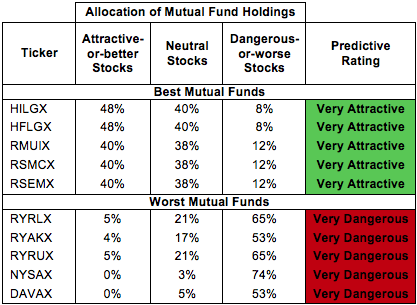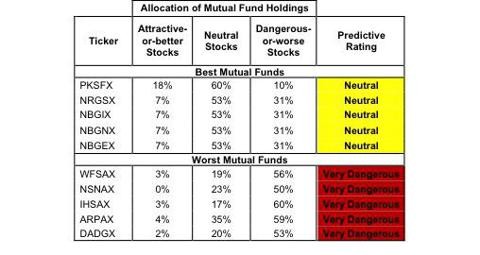Mutual Fund Styles
Post on: 2 Май, 2015 No Comment

There are four mutual fund styles that largely define a fund’s strategy for achieving its stated objective. The primary investing styles are: value, growth and blend, but aggressive growth should also be considered as a distinct style.
While style applies mainly to actively managed stock funds, it is also a factor in the classification of speculative bond funds and non-index commodity funds, although each of those has its own set of styles. Passively managed funds employ indexing with one of the three primary styles.
Value investing is the most conservative of the mutual fund styles. Value investing is fairly well defined by the investing philosophies of Dodd and Graham, who are considered to be the fathers of value investing. The essence of Dodd and Graham’s teachings involve analyzing securities with the intent of finding some gems that are priced well below their intrinsic value, then buying and holding those securities until their price is in line with their intrinsic value. In general, such companies are out of favor with the market for some reason but are not what one would consider distressed.
Value investing is usually considered to be a conservative strategy, but that is not necessarily so. Some value funds invest a significant portion of their assets in companies classified as being distressed, which is not the type of value play that Dodd & Graham had in mind. There’s a very broad gray area between distressed and undervalued which makes it difficult to clearly define a fund manager’s use of the value strategy. Be sure you understand what type of value plays a fund’s manager prefers before you buy a value fund, as these fund managers do not all adhere strictly to the teachings of Dodd and Graham.
An example of a distressed company would be one with a strong brand that fell on hard times but is now emerging from Chapter 11. Right out of Chapter 11, it would be considered to be distressed. Over the next couple of years it will become apparent if the company’s plan for reorganization is viable and if the reorganization is being executed effectively. If the plan and execution are good, the company will, over time, move across the gray are from distressed to undervalued or fully valued. I recall Wickes Lumber going through this in the early 1980s, and there have been others that have gone down in flames then arose from the ashes.
An example of an undervalued company would be one that lost a large contact that investors had assumed to be a slam dunk and was thus reflected in the price of the company’s stock. When investors learn of the loss of the contract, a selling frenzy will likely ensue, which will probably result in the stock being oversold, i.e. its price falls well below intrinsic value. But the company is large, well run, has plenty of other contracts and has a healthy balance sheet. Buying this company’s stock when it is priced below intrinsic value is a classic Dodd & Graham value play, as the company’s stock price will almost definitely rebound to its intrinsic value after investors recover from the shock. It’s not unusual for something like this to happen to a company like Boeing, for instance.
Now, you may be thinking Don’t both examples involve undervalued companies? The answer is Maybe. In the case of the distressed company, an optimist would consider it to be undervalued and thus a good value investment. However, there is a tremendous amount of risk involved, as the company has much to overcome before it can recover its strength, regain its market position and become profitable. During this recovery period it will sail across the gray area and risk being sunk in stormy seas before it reaches the other side, but the closer it gets to the other side, the better its chances of making it. So at some point on that journey it could become a classic value play if the recovery of its stock price significantly lags its intrinsic value.
The value strategy is contrary to the efficient market hypothesis, but the general consensus is that the hypothesis is only valid over the long term and that there can be inefficiencies in the short term. Many people, including Warren Buffett, have proven this to be the case. This is classic buy low/sell high investing.
Growth investing is a moderate investing style. Growth investors also strive to buy low and sell high, but they’re willing to pay intrinsic value for the securities of companies that are in the growth stage of their life cycle or are poised to grow at a relatively rapid rate, thus providing an acceptable risk-adjusted return on investment (ROI). They will hold these companies’ securities as long as they remain in the growth stage and there are no negative changes in the companies’ fundamentals. But the possibility of negative developments in the companies’ fundamentals poses a serious risk. If such changes are not foreseen by the funds’ analysts, stock prices can fall before the funds’ have time to unwind their positions in the faltering companies and the funds will suffer losses.
Blend is a mutual fund style that employs a combination of value investing and growth investing. This blending can happen in two ways.
First, they can select growth stocks on a value basis. If their assessment of the growth stocks they buy on a value basis is correct, they get returns from both growth and the eventual adjustment of the stocks’ prices to their intrinsic value. Second, blend funds also may make pure value and pure growth investments, thus making their portfolios a blend of growth and value investments.
You should note that it’s not unusual for value funds to own some growth stocks for the purpose of boosting their performance while they’re waiting for their value plays to pay off. These funds, that are predominantly value, often get classified as blend funds, so don’t restrict your search for value funds strictly to the value category. This is yet another case where you need to dig a little deeper to determine a fund’s true nature.
Aggressive growth investing is the least conservative of the investing styles. Aggressive growth funds go beyond just plain growth in a few ways. These funds my employ momentum investing, invest in securities that are well above average in risk, and make liberal use of debt and derivatives, all of which increase the funds’ overall risk.
Buying securities that offer potentially high returns but have commensurately high risks is a risky proposition, but broad diversification can diminish the aggregate risk. However, sector funds are very limited in the breadth of their diversification, a point that you should definitely keep in mind if you’re considering sector funds that are classified as aggressive growth.
Momentum investing is more a strategy than a mutual fund style, and it’s an aggressive strategy. Momentum investing is like surfing along a rocky coast, where the objective is to catch an exhilarating ride on a big wave and bail out before you’re pounded into the rocks. If you fail to execute this properly, you lose big.
Momentum investors buy securities, usually stock, that are experiencing rapidly rising prices, i.e. they appear to have a lot of momentum. Quite often these securities will be rising in price mainly because they’re hot and people are buying because other people are buying, rather than because of some change in the companies’ fundamentals that justifies their rising prices, and the momentum usually drives prices well beyond intrinsic value. Just like riding a wave toward a rocky coast, you need to know when to bail out. This strategy is obviously not for the faint of heart.
The use of debt, i.e. leverage, magnifies a fund’s inherent risks. It increases the amplitude of the fund’s volatility both up and down.

The liberal use of derivatives for anything other than hedging will also magnify a fund’s inherent risks, but they have a greater potential than debt to increase a fund’s volatility.
Concentrated funds deliberately concentrate their investments in a relatively small number of companies, usually in the range of 30 to 60. This strategy can be used with any of the mutual fund styles described above and thus defines a subset of those styles.
Index funds conform to one of the three primary mutual fund styles: value, growth or blend. Thus they, too, form a subset of styles.
The foregoing discussion of the mutual fund styles employed in the management of stock funds also applies to the stock portion of hybrid and balanced funds. So be sure to read the prospectus before investing.
The style used to manage a bond fund that invests in speculative grade bonds is hard to pin down. By their very nature, they are not conservative and therefore might be considered aggressive, and some of them do employ a very aggressive strategy. However, depending on your perspective, their style could be classified as value. Making this distinction hinges on the reasons for the bonds in any particular portfolio being rated as speculative, i.e. below investment grade. Some are much more speculative than others. Again, be sure to read the prospectus before investing.
Commodity funds come in three flavors that can be roughly equated to mutual fund styles: commodity index funds, commodity stock funds and managed futures funds. So there are three ways of accomplishing about the same thing: providing exposure to the commodities markets for the sake of diversification.
As you can see, investing styles are essential in defining mutual funds’ investing strategies for achieving their objectives.
1 2 3 4 5
Section Intro Next Section














